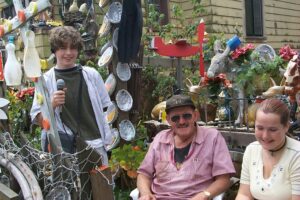We want to share once again some excerpts from the oral history project that was created back in 2000 by the students of Ryan Olson Day’s Options Class at the Mendocino Middle School. With the help of Steven Jordan and a grant obtained by Deena Zarlin, they made audio recordings of their interviews with 12 “Old Timers,” who told the kids what it was like living here on the Coast in the first part of the 20th century.

Richie’s interview was conducted by students Adam Channel and Jennifer Vought, with Steve Jordan and Deena Zarlin helping out.
They are visiting Richie at his family home, built by his father in 1912 on Kelley Street. His dad was Manuel Maria Silveria, one of three brothers who came to Mendocino from the Portuguese Azores Islands about 1910. They married the three daughters of Casimero and Isabelle Silvia of Mendocino.
Shortly thereafter, these brothers convinced William Heeser to create Kelly Street at the west end of town and lay out three buildable lots on which they could construct homes for their brides. All three families lived out their lives on their three adjacent properties on the west side of Kelly Street.
In 2000, Richie has been here since his birth and the yard reflects his special touch. Jennifer, exclaims, “Your yard is amazing. It’s filled with all kinds of things from abalone shells to ancient stuff. What inspired you to make your house like this?”
Richie replies, “Well when I was 15 years old, I went down to the Portagee beach and I got a piece of driftwood and I started when I was 15 years old and I started collecting everything and that’s the way it went.”
Jennifer says, “Wow! It seems like some of the stuff has a sentimental meaning. Does each piece have a meaning?” And he says, “Different people gave me stuff and everything. And I just think of them you know.”
Adam asks if he had any pets. “Well, I had horses. I had a jackass, a donkey, and we used to ride with Sverko and Joe Lenhares. We’d ride down to Big River and then go up to Boyle’s camp up that way. Kept them right here by the house in the back, or in Manuel Manesa’s place over here up by the Crown Hall and Joe Rigo by the post office. Lots of animals in town.”
They ask what the beaches were like. He describes how easy it was to pick up a handful of abalone, even with your Sunday-best clothes on, there were so many. And how plentiful driftwood was back then, “but now the rangers won’t let you pick up anything.”
“We used to have a small boat down there in the boat house on Portagee Beach but afterwards they tore them down and we got rid of the boat.”
Richie told them how he and his friends would go down to Schlafer’s and get a car wheel and roll it all over town for fun, even up to the Catholic Church and then roll down the hill with it.
Then he says, “There was a chute down here at The Point where my grandfather and my father used to work, and they used to put the lumber down the chute, and I used to ride down the chute all the time.” “From the chute down to the ship?” Richie: “Yeah.”
Turns out that Steve Jordan’s grandfather worked there, too. “He would ride the lumber down and sometimes the timber would tip, and they’d fall into the ocean and they would have to swim back to shore.”
Different times!
Copies of the transcripts and audio recordings of these “Old Timers” stories are available from the Kelley House Museum. For details, email Director-Curator Karen McGrath at curator@kelleyhousemusem.org